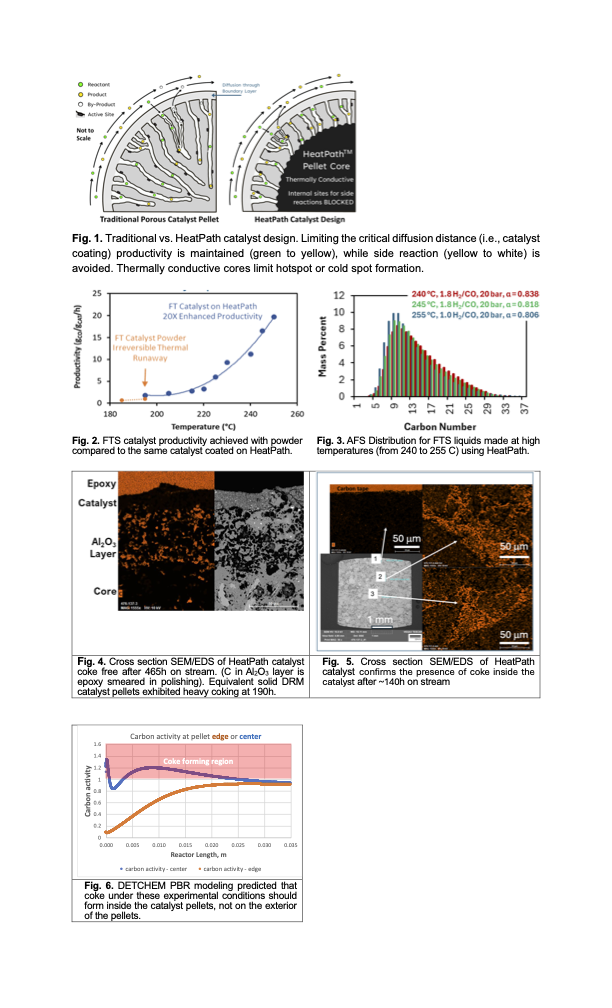To meet the goals of the 2021 White House SAF Grand Challenge [1] the US must produce 3B gpy of SAF with >50% lower GHG emissions versus Jet A in 2030; and 35B gpy by 2050. Global 2022 SAF production was 26.5M gpy [2], less than 1% of the 2030 target. Current SAF routes cannot compete with Jet A on cost, but the Grand SAF Challenge increased airlines’ financial incentive, adding $1.25/gal in SAF tax credits. As a result, there is intense interest in low-cost, low-carbon intensity SAF, particularly CO2 neutral (or negative) blend-stocks. Achieving these aggressive goals requires many new technologies, including catalyst and simulation capabilities. In this work, we focus on two important chemistries for SAF: Fischer-Tropsch Synthesis (FTS) and syngas production from biogas by Dry Reforming of Methane (DRM). In both cases, HeatPath catalysts were used to achieve superior performance compared to conventional catalysts.
HeatPath [3] is catalyst carrier, with a high thermal conductivity SiC-Al2O3 composite core, bonded to a hermetic and roughened protective alumina surface layer. The rugged surface enhances catalyst coating adhesion, allowing the demonstration of various catalysts. HeatPath’s key innovations include the enhancement of bulk tablet thermal conductivity by 4-10X over conventional tableted catalysts (depending on catalyst formulation and reactor operating temperature), enabling rapid thermal response in highly thermic reactions. Further, the thin catalyst coating over the hermetic core eliminates internal catalyst sites that can promote byproduct formation or product decomposition (Fig. 1).
For exothermic FTS, HeatPath avoids localized hotspots that cause thermal runaway, allowing unprecedented operating temperature and reactor efficiency (high CO conversion and low CH4 production) with stable long-chain FTS production [4]. Even at high temperatures (>250°C) for the cobalt-based catalyst (Fig. 2), HeatPath maintains high fractions of high-carbon products (Fig. 3).
Dry reforming allows the use of renewable biogas feedstocks to produce SAF. For DRM, at a steam to carbon ratio (S:C) down to 0.3, the HeatPath catalyst ran for 450 hrs without coke formation on the exterior or interior of the catalyst, confirmed by SEM EDS of selected pellets, Fig. 4. A conventional DRM catalyst pellet, meanwhile, deactivated when operated with a S:C below 1.5. Although no coke was found on the exterior of the conventional catalyst, coke formed in the interior of the catalyst (Fig. 5).
The common denominator behind the superior performance of the FT and DRM results is the thin coating on the highly conductive HeatPath core. The “secret life of catalysts” occurs inside catalyst structures (e.g., pellets, powders, and wall coated catalysts), where transport is controlled by diffusion and where series or series-parallel reactions can dominate. Although this internal region physically contains most catalyst sites, complex reactions inside pore structures are generally poorly analyzed and rarely optimized. Side reactions that occur deep inside a catalyst can be conflated with an intrinsic catalyst problem.
DETCHEM [5] is a suite of accessible reaction engineering tools designed to help to understand what happens inside a catalyst, integrating:
- multi-step reaction kinetics, either from microkinetic models with perhaps hundreds of steps or apparent rates with a few steps, coupled with
- catalyst internal pore diffusion that may be molecular, Knudsen, or mixed, coupled with
- realistic heat transfer models, such as state-of-the art correlations for packed beds, structures, or open channels, to model the flow of heat that results from exterior heating/cooling along with endo- or exothermic heat transfer demands linked with the kinetic mechanisms.
Analysis with DETCHEM PBR identified a CO concentrating effect inside the catalyst pellet which leads to the carbon activity exceeding one (Fig. 6). When carbon activity exceeds a value of one, coke is thermodynamically favored to form. DRM modeling was based on an experimentally fit apparent kinetics for a simplified reaction network consisting of DRM, Water Gas Shift (WGS), and Steam Methane Reforming (SMR) steps.
In sum, two important chemistries needed to produce SAF were found to have dramatically improved performance when using HeatPath catalysts. The improved performance is directly related to the thin coating on a conductive core. Coupled with accessible simulation tools like DETCHEM, internal pore chemistry effects can be modeled and analyzed, supporting the design of improved catalysts and reactors to accelerate the adoption of cost-effective SAF.
References
[1] DOE. 2021. “Memorandum of Understanding: Sustainable Aviation Fuel Grand Challenge.” Sept. 8, 2021. https://www.energy.gov/sites/default/files/2021-09/S1-Signed-SAF-MOU-9-08-21_0.pdf. (last accessed 3/22/24)
[2] IATA - 2022 SAF Production Increases 200% - More Incentives Needed to Reach Net Zero (last accessed 3/22/24)
[3] HeatPath Solutions. https://heatpathsolutions.com . Accessed March 11, 2024.
[4] Zhang R, Li J, Tonkovich A, Lockhart C, Wang X, Hu W, Karroum H, Seabaugh M, Kruse N, Wang Y. Highly productive and robust core@shell HeatPath SiC-Al2O3 @Co/Re/Al2O3 catalyst for Fischer–Tropsch synthesis. App. Cat A 2023; 666: 119419. https://doi.org/10.1016/j.apcata.2023.119419
[5] omegadot software & consulting, GmbH. DETCHEM v3.0 2024. www.omegadot.software . Accessed March 6, 2024.


